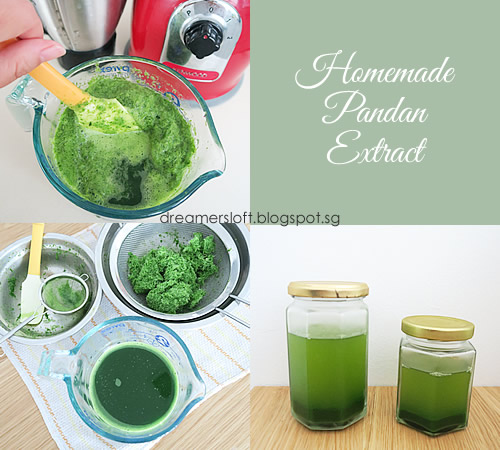One of the kuehs I wanted to make was Kueh Dadar and my excuse was I don't have a shallow pan or crepe pan to make the skin wrap. Well, I've been eyeing a crepe pan but once again kept procrastinating because I don't want to have another white elephant in my kitchen. But without a crepe pan, I cannot make crepes and such right? Ok fine, lame excuses.
Finally got my hands on a crepe pan, thanks to a friend CT who got me an irresistible discount :) #nomoreexcuses
My go-to recipe is definitely the one by Alan of Travelling-Foodies. He provided very comprehensive details on preparing the inti (filling) as well as videos of how to make and cook the skin wrap, which makes the process much easier to follow.
But before I get started on making the kueh proper, I have to make pandan extract first as I don't feel like buying pandan paste off the shelf. There are many websites and videos showing how to do homemade pandan extract so I shall not go into details. Basically I used 3 stalks of pandan (with around 30+ leaves), blended with 200-250ml of water to get a pandan pulp. Squeeze the juice from the pulp and store the juice in glass bottle overnight in the fridge. The dark green part that sank to the bottom is the most concentrated extract.
And with that, I finally got down to making my first Kueh Dadar! No step-by-step photos as I was trying to multi-task on another bake (Pandan Chiffon using cooked dough method), as well as planning for lunch and dinner and in between FB-ing and Instagram-ing :p
With reference from Travelling-Foodies, I halved the recipe for the Inti (filling) and used about 65% for the skin wrap.
Kueh Dadar
(makes 7 rolls, slightly smaller than regular size)
Ingredients
Inti (filling)Steps
- 80g gula melaka, break into small pieces
- 3 tbsp pandan juice
- 150g grated coconut
- pinch of salt
Skin wrap
- Place gula melaka and pandan juice into a small pot over medium low heat.
- Once the gula melala melts, add the grated coconut and stir till well-blended.
- Add pinch of salt and cook the mixture till no more excess moisture. The mixture should be moist but not wet.
- Remove the pot from heat and set aside to cool.
Steps
- 130g plain flour
- 130 fresh coconut milk
- 50g concentrated pandan extract + 80g pandan juice
- 35g egg
- pinch of salt
- cooking oil
**My crepe pan is 22cm diameter and the skin wrap is about 14-15cm diameter. The rolls are slightly smaller than regular ones.
- Add flour, coconut milk, pandan extract/juice, egg and salt into a mixing bowl. Mix well into a thin batter. Add more flour or pandan juice as necessary.
- Strain the batter using a fine sieve to remove flour lumps and unbeaten egg white.
- Heat a non-stick pan over medium-low flame. Grease the pan lightly with cooking oil using a piece of kitchen paper.
- Lift the pan off the stove, pour a ladle of batter into the centre of the pan and quickly swirl the batter in circular motion to form a thin layer.
- Let the batter cook till the bottom side is able to slide around the pan. *This bottom side should have a pockmarked surface but not burnt.
- Flip the skin wrap and cook for 15-20 secs, then place the skin wrap onto a greased aluminum tin surface to cool. *This side should be smooth
- Repeat till all batter used up (stir the batter from time to time to prevent flour from settling at the bottom of the bowl).
Assemble
- Place a skin wrap on a cooking mat/board with the smooth surface facing upwards.
- Add about 1 heap tbsp of filling onto the skin wrap, about 1/3 of the wrap.
- Fold the left and right sides of the skin towards the centre covering most of the filling. Lift up the skin at the side nearer to you, and roll the skin over the filling in the direction away from you. Roll with a bit of pressure to make sure the filling is secured and roll is firm.
- Repeat till all the skin wrap and filling are used up.
- Ready to serve.
All in all, I yielded 7 rolls of Kueh Dadar (with 2 extra skin wraps spoil). Frankly quite a lot of effort put in just for these few rolls of Kueh Dadar!
That said, lots of improvement to be made! I think the filling was a tad too wet, I should have cooked it longer to remove more moisture. The filling was also too sweet for my liking, or maybe I filled too much into each skin wrap and it was too overwhelming. The skin wrap was also not soft enough, probably it was too thick?
Nonetheless, it was a good attempt and I'm really happy with my first try! Hope I can find time and energy to make more Kuehs on my to-do list soon :)





No comments:
Post a Comment